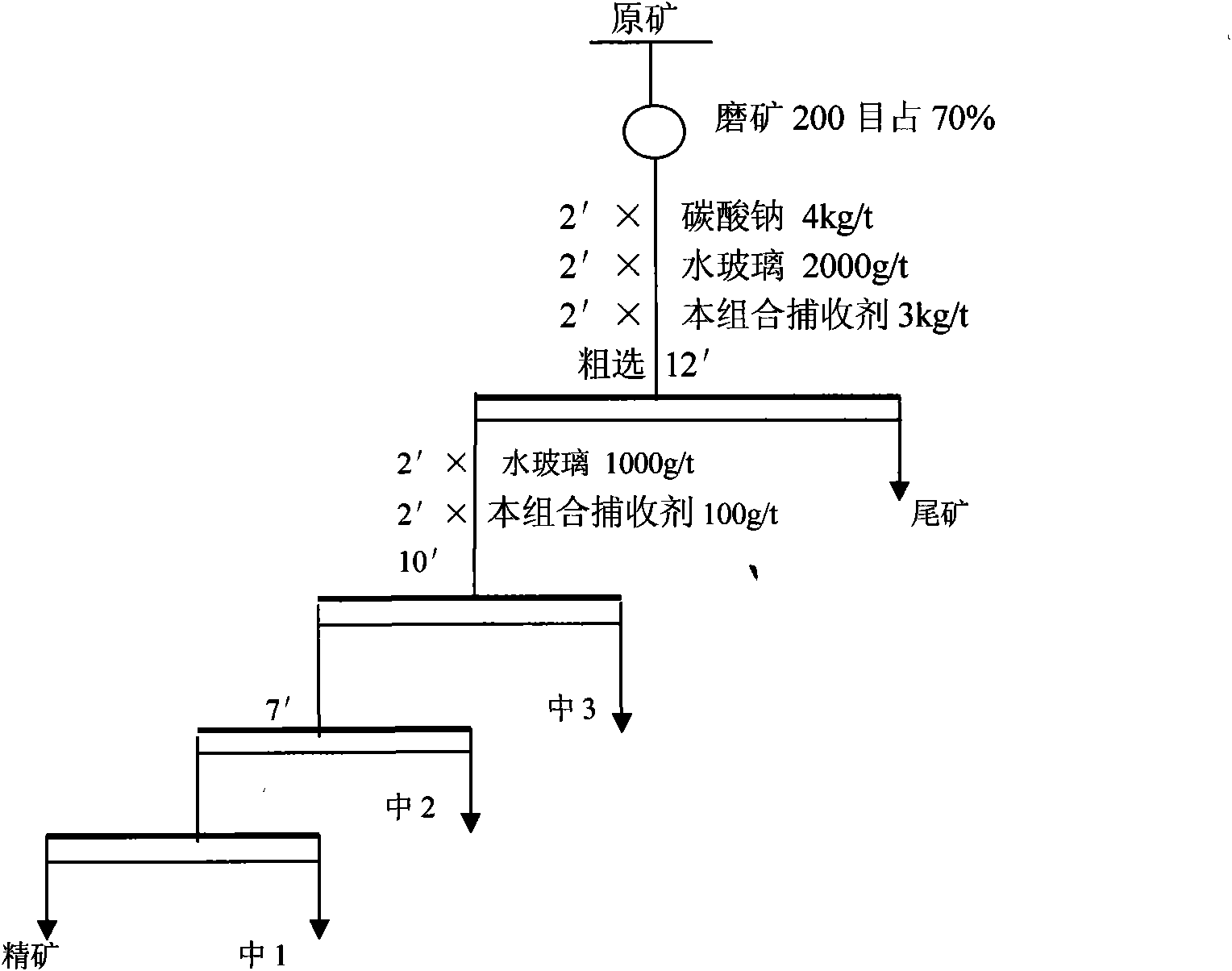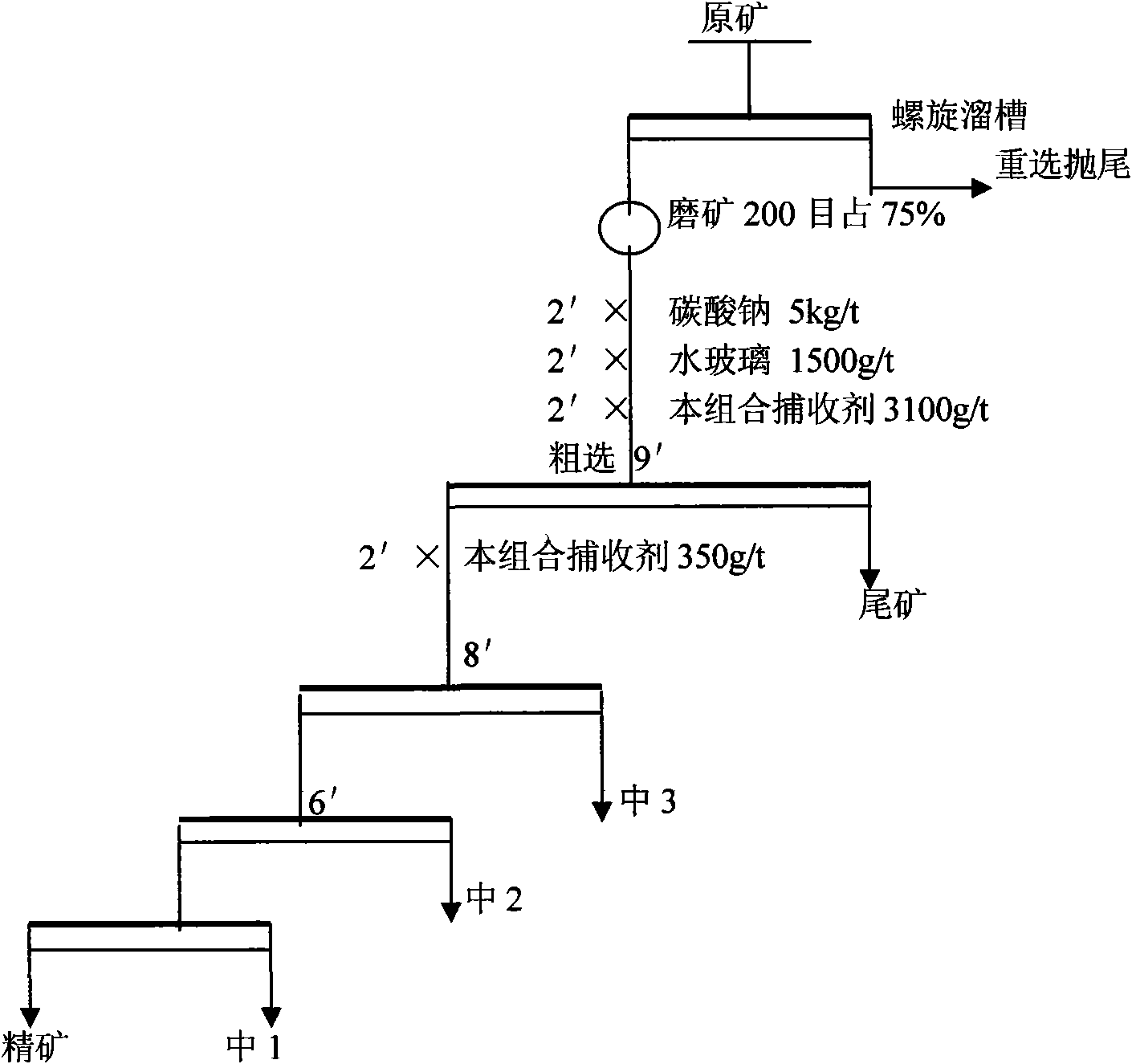Combined collector of phosphorite
A technology combining collector and apatite, applied in the field of collectors, can solve the problems of difficult defoaming, high foam viscosity and high cost, and achieve the effect of reducing flotation cost, reducing consumption and moderate price
- Summary
- Abstract
- Description
- Claims
- Application Information
AI Technical Summary
Problems solved by technology
Method used
Image
Examples
Embodiment 1
[0011] After processing the apatite-containing tailings of an iron ore in Longling by magnetic separation, the ore sample is a sandy soil sample, and its components are mostly muddy particles. Phosphorus minerals are mainly apatite, and gangue minerals mainly include Fushan stone, calcite, quartz, muscovite, biotite, epidote, etc. Among them, calcite is the majority, and other minerals are rare. See cuttings and metal minerals. There are roughly three types of cuttings: one is composed of clay minerals, argillaceous matter, sericite and biotite, of which biotite is relatively less; The cuttings are limestone cuttings (less common). Metal minerals include limonite and a small amount of magnetite. Magnetite is sometimes semi-euhedral and sometimes other-shaped granular. Limonite is irregular granular. The phosphorus grade of the tailings is low, about 18.56%. Some apatites are difficult to separate, and the mudification is serious. When the grinding fineness is 200 mesh, acco...
Embodiment 2
[0015] The ore sample comes from a certain place in Anning, Yunnan. From the spectral analysis table 2 and the diffraction pattern of the raw ore, it can be seen that the useful phosphorus mineral is fluorapatite, with a small content. The gangue contains a large amount of quartz, chlorite, muscovite and orthoclase. The slime content is large. The raw ore properties are shown in Table 3.
[0016] Table 2 Spectral analysis of ore samples
[0017] the element
Content%
the element
Content%
Aluminum (Al)
Phosphorus (P)
Manganese (Mn)
Magnesium (Mg)
Lead (Pb)
Iron (Fe)
3.00
10.00
0.3
greater than 1.00
0.01
greater than 1.00
sodium
other elements
0.1
Greater than 10.0
0.03
0.3
none
[0018] Table 3 Multi-element analysis results
[0019] project
P 2 o 5
TiO 2
Al 2 o...
Embodiment 3
[0025] The sample comes from a phosphate mine in Shandong, and the multi-element analysis result of the raw ore sample is: P 2 o 5 24.2%, MgO 5.04%, SiO 2 12.34%, Fe 2 o 3 7.89%, Al 2 o 3 1.05%, CaO4 0.64%, CO 2 9.87%. Belongs to siliceous calcium sedimentary phosphorite.
[0026] The grinding fineness used in the test is 200 mesh 90%, and the process adopts two closed-circuit grinding, one rough, three fine and one scavenging flotation process. The original drug system is the regulator sodium carbonate 6kg / t, the inhibitor MC (self-made) 1.5kg / t, the combined use of oleic acid and sodium dodecylsulfonate is 3.5kg / t, and the concentrate index is grade P 2 o 5 32.7%, recovery rate is 74.6%; After adopting this combined collector 2.5kg / t, proportioning is: oxidized paraffin wax soap: table salt: sodium oleate=2.4: 0.11: 0.9, be adjusted to sodium carbonate consumption 4kg / t, The index of flotation concentrate is grade P 2 o 5 31.97%, and the recovery rate was ...
PUM
 Login to View More
Login to View More Abstract
Description
Claims
Application Information
 Login to View More
Login to View More - R&D
- Intellectual Property
- Life Sciences
- Materials
- Tech Scout
- Unparalleled Data Quality
- Higher Quality Content
- 60% Fewer Hallucinations
Browse by: Latest US Patents, China's latest patents, Technical Efficacy Thesaurus, Application Domain, Technology Topic, Popular Technical Reports.
© 2025 PatSnap. All rights reserved.Legal|Privacy policy|Modern Slavery Act Transparency Statement|Sitemap|About US| Contact US: help@patsnap.com


